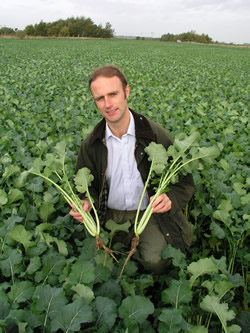
Picture: Mahon Brennan, Oilseed Rape Technical Manager for Monsanto showing advanced rape crops that need plant growth manipulation this autumn.
Growers that have chosen low biomass winter oilseed rape varieties have made the right decision, but in a year like this, a robust growth regulation programme should be considered for all rape crops, advises plant breeder, Monsanto.
"So far this year we have seen excellent establishment and excellent growing conditions, leading to very lush oilseed rape crops with high plant populations. This has been compounded by the fact that a lot of early drilling has taken place. As a result plants have taken up high levels of nitrogen and stem bases have not undergone the same level of lignification we would expect in more normal years. This has left us with very 'fleshy' stem tissue and poses a severe risk of lodging," says Mahon Brennan, Oilseed Rape Technical Manager for Monsanto.
"Preventing lodging in rape means a combination of growth manipulation and disease control. Growth manipulation helps to produce the ideal oilseed rape plant which should be short in stature with thick, strong stems, good branching and a strong root structure. Low biomass varieties are shorter but this autumn, as for all other varieties, are more sappy and lush and so will require some growth regulation, along with the moderate and higher biomass varieties. Thicker stems help improve canker resistance and shorter crops are less prone to lodging. More branching results in fewer seed losses and improved rooting improves nitrogen and nutrient utilisation and water uptake in May and June. But achieving the ideal plant structure for all rape varieties in the spring requires crop management in the autumn," reminds Diane Heath, BASF Oilseed Rape Product Manager. MORE…........
The way that Caramba (metconazole) works is by affecting the hormone balance in the plant. The reduction of the plant hormone, gibberellin, diverts assimilates to initiate and promote branch and root development and also reduces apical dominance, reducing stem length. The increase in cytokinins encourages cell division in roots and shoots and results in more chloroplasts.
"Autumn Caramba acts both as a plant growth regulator and fungicide and is appropriate for use on most rape crops. The exceptions are crops under visible stress. There are very few crops this year in this exempt category," says Diane Heath.
